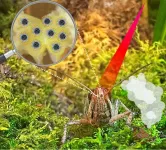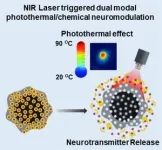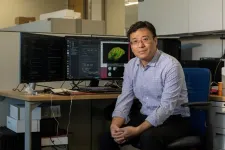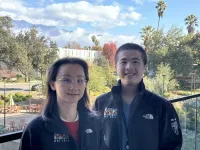(Press-News.org) Our sensory systems are highly adaptable. A person who cannot see after turning off a light in the night slowly achieves superior power to see even small objects. Women often attain a heightened sense of smell during pregnancy. How can the same sensory system that was underperforming can also exceed the expectation based on its prior performance?
Since nature has perfected its sensory systems over evolutionary time scales, an interdisciplinary team of researchers in the McKelvey School of Engineering at Washington University in St. Louis tapped into these capabilities to adapt the system on demand to perform at its peak performance. Their tools to achieve this goal: locusts and nanomaterials too small to see.
Srikanth Singamaneni and Barani Raman, both professors in the McKelvey School of Engineering, led a team that harnessed the power of specially made nanostructures that can absorb light and create heat, known as the photothermal effect, and act as containers to store and release chemicals on demand. They used these nanostructured materials to boost neural response in the locust's brain to specific odors and to improve their identification. Results of the research were published in Nature Nanotechnology Jan. 25, 2024.
Singamaneni, the Lilyan & E. Lisle Hughes Professor in the Department of Mechanical Engineering & Materials Science, and Raman, professor of biomedical engineering, have collaborated for years with Shantanu Chakrabartty, the Clifford W. Murphy Professor in the Preston M. Green Department of Electrical & Systems Engineering, to harness the superior sensing capabilities of the locust olfactory system. Recently they demonstrated the feasibility of using a bio-hybrid electronic nose for sensing explosive vapors.
“We let the biology do the harder job of converting information about vaporous chemicals into an electrical neural signal,” Raman said. “These signals are detected in the insect antennae and are transmitted to the brain. We can place electrodes in the brain, measure the locusts’ neural response to odors, and use them as fingerprints to distinguish between chemicals.”
The idea, though sound, has a potential roadblock.
“We are limited by the number of electrodes and where we can place them,” Singamaneni said. “Since we will get only a partial signal, we want to amplify this signal. This is where we turned to heat and neuromodulation to enhance the signal we get.”
In the new research, the team used two strategies to boost the locusts’ ability to detect odors. First, the team created a biocompatible and biodegradable polydopamine nanoparticle that converts light to heat through a process called photothermal effect.
"Heat affects diffusion,” Raman said. “Imagine adding cold milk to hot coffee. The idea is to use the heat generated by nanostructures to locally heat, for example, a nanoheater, and enhance the neural activity.”
Second, these nanostructured materials can be made to load chemicals for storage. However, they need to be encapsulated by a covering material. The team used a phase-change material called tetradecanol which is solid at room temperature and transitions to liquid upon heating. When heated, the same nanoheaters will ooze the chemicals stored within them in addition to generating heat.
Singamaneni and the team stored octopamine, a neuromodulator involved in various functions, and released it on demand. Usually, these neuromodulators are released based on the needs of the organism. However, using the nanostructured heaters, they were released on demand to enhance the neural signals.
“Our study presents a generic strategy to reversibly enhance neural signals at the brain site where we place the electrodes,” Raman said.
“The nano-enabled neuromodulation strategy we developed opens new opportunities to realize tailored cyborg chemical sensing approaches,” said Prashant Gupta, a graduate student in Singamaneni’s lab and first author of the paper. “This approach would change an existing passive approach where information is simply read into an active one where the capabilities of the neural circuits as a basis for information processing are fully used.”
###
Gupta P, Chandak R, Debnath A, Traner M, Watson BM, Huan H, Gholami Derami H, Baldi H, Chakrabartty S, Raman B, Singamaneni S. Augmenting Insect Olfaction Performance through Nano-Neuromodulation. Nature Nanotechnology, Jan. 25, 2024, https://doi.org/10.1038/s41565-023-01592-z
Funding for this research was provided by the Air Force Office of Scientific Research (#FA95501910394) and the Office of Naval Research (#N000142112343).
END
Locusts’ sense of smell boosted with custom-made nanoparticles
Wash U researchers amplify neuron signals from insect brain to achieve better chemical sensing performance
2024-01-26
ELSE PRESS RELEASES FROM THIS DATE:
Landmark $5 million donation to University of Ottawa's Telfer School of Management from Patricia Saputo
2024-01-26
The University of Ottawa is proud to announce it has received a $5 million donation from Patricia Saputo, a multi-generational family enterprise leader and advocate, to provide thought leadership and training through the Family Enterprise Legacy Institute at the Telfer School of Management.
The gift has created the endowed Patricia Saputo Distinguished Chair in Family Enterprise, which will support academic leadership for the institute and nurture long-term research projects aimed at developing best practices on critical topics for family enterprises.
“This generous gift makes ...
New tool helps predict progression of Alzheimer’s
2024-01-26
About 55 million people worldwide are living with dementia, according to the World Health Organization. The most common form is Alzheimer’s disease, an incurable condition that causes brain function to deteriorate.
In addition to its physical effects, Alzheimer’s causes psychological, social and economic ramifications not only for the people living with the disease, but also for those who love and care for them. Because its symptoms worsen over time, it is important for both patients and their caregivers to prepare for the eventual need to ...
Political polarization may slow legislation, make higher-stakes laws likelier
2024-01-26
The United States House of Representatives held more than 700 votes in 2023, but fewer than 30 bills were signed into law. Partisan politics may explain why, with polarization potentially causing enough friction to slow down the legislative process and make the passage of fewer, farther-reaching public laws likelier, according to researchers.
The collaborators from Penn State and Colorado State University studied levels of polarization and patterns in the passage of budget bills and public laws from 1948 through ...
Common cold or COVID-19? Some T cells are ready to combat both
2024-01-26
Scientists at La Jolla Institute for Immunology (LJI) have found direct evidence that exposure to common cold coronaviruses can train T cells to fight SARS-CoV-2. In fact, prior exposure to a common cold coronavirus appears to partially protect mice from lung damage during a subsequent SARS-CoV-2 infection.
The new research, published recently in Nature Communications, provides an important first look at how "cross-reactive" T cells—which can fight multiple viruses from the same family—develop in an animal model. "We are learning how these immune cells develop ...
The science behind mindfulness: How one University of Ottawa professor embraced it for the benefit of her students
2024-01-26
Understanding the neuroscience and physiological basis of the brain and training its networks to combat anxiety and life’s stressors
Professor Andra Smith, from the School of Psychology at the Faculty of Social Sciences, has combined her research and her personal experience with mindfulness to teach the course Neuroscience of Mindfulness: Neurons to Wellness. Her interest in neuroscience explores how to optimize cognitive processes behind decision-making, organizing behaviour, setting goals while taking the necessary steps ...
UC Irvine-led team unravels mysteries of planet formation and evolution in distant solar system
2024-01-26
A recently discovered solar system with six confirmed exoplanets and a possible seventh is boosting astronomers’ knowledge of planet formation and evolution. Relying on a globe-spanning arsenal of observatories and instruments, a team led by researchers at the University of California, Irvine has compiled the most precise measurements yet of the exoplanets’ masses, orbital properties and atmospheric characteristics.
In a paper published today in The Astronomical Journal, the researchers share ...
Confirmation of ancient lake on Mars builds excitement for Perseverance rover's samples
2024-01-26
If life ever existed on Mars, the Perseverance rover’s verification of lake sediments at the base of the Jezero crater reinforces the hope that traces might be found in the crater.
In new research published in the journal Science Advances, a team led by UCLA and The University of Oslo shows that at some point, the crater filled with water, depositing layers of sediments on the crater floor. The lake subsequently shrank and sediments carried by the river that fed it formed an enormous delta. As the lake dissipated over time, the sediments in the crater were eroded, forming ...
USC Stem Cell study shows how gene activity modulates the amount of immune cell production in mice
2024-01-26
As people age or become ill, their immune systems can become exhausted and less capable of fighting off viruses such as the flu or COVID-19. In a new mouse study funded in part by the National Institutes of Health and published in Science Advances, researchers from the USC Stem Cell lab of Rong Lu describe how specific gene activity could potentially enhance immune cell production.
“Hematopoietic stem cells, or HSCs, produce blood and immune cells, but not all HSCs are equally productive,” said the study’s corresponding author Rong Lu, PhD, ...
How waves and mixing drive coastal upwelling systems
2024-01-26
They are among the most productive and biodiverse areas of the world's oceans: coastal upwelling regions along the eastern boundaries of the Atlantic and Pacific Oceans. There, equatorward winds cause near-surface water to move away from the coast. This brings cold, nutrient-rich water from the depths to the surface, inducing the growth of phytoplankton and providing the basis for a rich marine ecosystem in these regions.
In some tropical regions, however, productivity is high even when the upwelling favourable winds are ...
How a timekeeping gene affects tumor growth depends entirely on context
2024-01-26
JANUARY 23, 2024, NEW YORK – A Ludwig Cancer Research study has found that the circadian clock—which synchronizes physiological and cellular activities with the day-night cycle and is generally thought to be tumor suppressive—in fact has a contextually variable role in cancer.
“A lot of evidence suggests that the biological clock is broken in cancer cells, so we expected its disruption would fuel tumor growth in mouse models of melanoma,” said Chi Van Dang, scientific director of the Ludwig Institute for Cancer Research, who led the study with Research Associate Xue Zhang. “But, contrary to our expectations, ...
LAST 30 PRESS RELEASES:
Tracing the quick synthesis of an industrially important catalyst
New software sheds light on cancer’s hidden genetic networks
UT Health San Antonio awarded $3 million in CPRIT grants to bolster cancer research and prevention efforts in South Texas
Third symposium spotlights global challenge of new contaminants in China’s fight against pollution
From straw to soil harmony: International team reveals how biochar supercharges carbon-smart farming
Myeloma: How AI is redrawing the map of cancer care
Manhattan E. Charurat, Ph.D., MHS invested as the Homer and Martha Gudelsky Distinguished Professor in Medicine at the University of Maryland School of Medicine
Insilico Medicine’s Pharma.AI Q4 Winter Launch Recap: Revolutionizing drug discovery with cutting-edge AI innovations, accelerating the path to pharmaceutical superintelligence
Nanoplastics have diet-dependent impacts on digestive system health
Brain neuron death occurs throughout life and increases with age, a natural human protein drug may halt neuron death in Alzheimer’s disease
SPIE and CLP announce the recipients of the 2025 Advanced Photonics Young Innovator Award
Lessons from the Caldor Fire’s Christmas Valley ‘Miracle’
Ant societies rose by trading individual protection for collective power
Research reveals how ancient viral DNA shapes early embryonic development
A molecular gatekeeper that controls protein synthesis
New ‘cloaking device’ concept to shield sensitive tech from magnetic fields
Researchers show impact of mountain building and climate change on alpine biodiversity
Study models the transition from Neanderthals to modern humans in Europe
University of Phoenix College of Doctoral Studies releases white paper on AI-driven skilling to reduce burnout and restore worker autonomy
AIs fail at the game of visual “telephone”
The levers for a sustainable food system
Potential changes in US homelessness by ending federal support for housing first programs
Vulnerability of large language models to prompt injection when providing medical advice
Researchers develop new system for high-energy-density, long-life, multi-electron transfer bromine-based flow batteries
Ending federal support for housing first programs could increase U.S. homelessness by 5% in one year, new JAMA study finds
New research uncovers molecular ‘safety switch’ shielding cancers from immune attack
Bacteria resisting viral infection can still sink carbon to ocean floor
Younger biological age may increase depression risk in older women during COVID-19
Bharat Innovates 2026 National Basecamp Showcases India’s Most Promising Deep-Tech Ventures
Here’s what determines whether your income level rises or falls
[Press-News.org] Locusts’ sense of smell boosted with custom-made nanoparticlesWash U researchers amplify neuron signals from insect brain to achieve better chemical sensing performance








